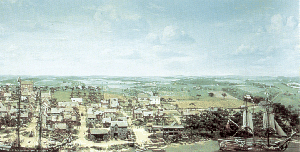History of Medicine


Origins of the National Institutes of Health

Many colonial towns, like Fredricksburg, Virginia, were founded as far inland as ships could navigate.
Today it is not easy to recognize the vast importance and close ties that public health and maritime health had in earlier American history. Originally, the Colonies were only seaports on the Atlantic Coast, with outlying dependencies. Interconnection was by ship. The Colonies had strict local sanitation laws and were keenly aware of the disease threat carried by ships and sailors. Their entry into ports was controlled by local laws as early as 1699, when Philadelphia traced it first yellow fever epidemic to a ship from Barbados and passed "An act to prevent Sickly Vessels from Coming into this Government." During the 1700's "health officers" were appointed by communities to enforce maritime quarantine laws. Ships suspected of carrying contagious disease were held in isolation for a period of 40 days. To show this quarantine, ships were required to fly a yellow flag. The yellow background of the U.S. Public Health Service flag commemorates this history.
